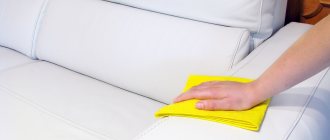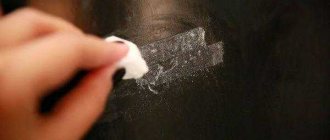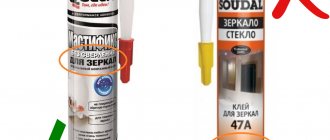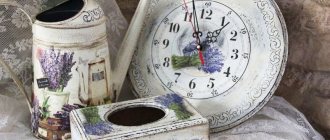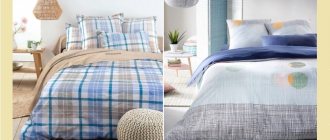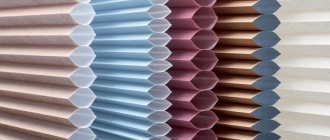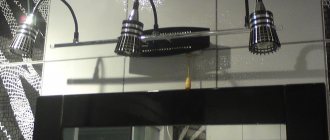How to care for furniture: general rules
- Move furniture away from fireplaces, stoves and radiators by half a meter, or better yet, by a meter. Under the influence of hot air, wood quickly loses its aesthetic appeal, veneer and PVC film peel off, and even unpretentious plastic becomes dull.
- Humidify the air in the room. During the heating season, not only furniture made of wood, but also furniture made of MDF, chipboard, rattan, and leather can crack due to excessive dryness.
- If something spills, wipe it up immediately, do not use rags that are too wet when cleaning, and do not leave wet things on cabinet furniture. Water causes wood and veneer to become deformed. The PVC film itself does not get wet, but moisture easily seeps under the edges of the parts, as a result the MDF or chipboard swells. Nothing can correct such a defect. And even if a number of materials (glass, plastic, stone) themselves can withstand moisture, it will negatively affect the fittings or simply leave unsightly stains.
Furniture surfaces are damaged by contact with water
- Use coasters for dishes; do not place hot household appliances (for example, irons or curling irons) on furniture. Varnish, veneer, wood and polished surfaces suffer from hot and cold.
- Wipe any furniture with a soft cloth, such as microfiber, that does not leave lint. It is better to avoid brushes and sponges for washing dishes, because almost all surfaces can be scratched with proper care. For some types of coatings (especially matte), a melamine sponge becomes a salvation.
- Don't forget about the fittings. Hinges, closers, guides and various kinds of latches are hidden from view, but every few months it is worth checking their condition, lubricating and tightening them. Over time, you won't suddenly have to deal with the fact that the handle is wobbly and the drawer won't close.
You need to check the condition of the fittings once a month.
- Assemble new furniture exactly according to the instructions and place it on a flat surface. If you have doubts about your abilities, call a specialist. This way you will protect yourself from deformation of the furniture immediately after purchasing it.
- Do not overload shelves and drawers, do not slam doors - all this will extend the functionality of the headset for at least a couple of years.
Proper use is the key to beautiful furniture
Cabinet furniture is a three-dimensional structure that is assembled from several parts. Moreover, the load is distributed evenly across all its parts, so when installing it is necessary to initially decide on the place where it will stand and assemble it there. After all, when moving furniture, the load is distributed incorrectly and there is a possibility of doors or shelves being skewed.
When placing things on shelves, you should not overload them, because each shelf is designed for a certain load. Proper distribution of things will maintain the rigidity of the structure. The heavier the item, the lower it should be located in the closet. This simple rule will keep the shelves and fastening mechanisms in their original condition. Also, it is worth remembering the need for timely repairs and replacement of worn parts.
Caring for wooden furniture
When wiping wooden furniture, run the rag in the direction of the wood grain. This will help to effectively remove dust and not “clog” the texture of the material.
If dry wiping is not enough, use a cloth soaked in soapy water, but wring it out thoroughly first. Next, remove the moisture with a dry cloth and rub the furniture with wax.
Polish only dry, dust-free furniture
Furniture products based on waxes and oils help preserve the beauty of polished and varnished wood, give it shine, and protect it from drying out. Apply polish to a soft cloth and rub in in a circular motion. Use polishing compounds no more than once every couple of months: excess waxes on the surface worsen the appearance and contribute to the accumulation of dust.
The appearance of tiny holes on wooden furniture requires surgical intervention - this is the work of insects. You need to treat the furniture with a pest control compound or call specialists who will do it for you.
Furniture damaged by insects can be saved if carefully treated with special preparations
Also read : What kind of wood is furniture made from - durable and beautiful.
Tips for removing stains
⦁ White spots from hot foods are removed using burdock oil or ammonia; ⦁ A weak solvent without acetone in the composition can remove traces of cosmetics and felt-tip pens; ⦁ talc or raw potatoes help get rid of greasy stains; ⦁ stains from ink or brilliant paint are removed with an eraser, and then treated with a soap solution. If you are not sure of the origin of the stain, you can try to remove it by ⦁ treating it with iodine diluted with water in a 1:1 ratio; ⦁ rubbing with a mixture of dry red wine or lemon juice with vegetable oil, taken in equal parts; ⦁ beer.
Any compounds must be thoroughly removed after removing the stain.
Caring for furniture made of MDF and chipboard
MDF and chipboard are types of particle boards. In furniture production, composite materials are refined by gluing PVC (polyvinyl chloride) film onto them.
MDF and chipboard boards can be decorated with films of different textures and colors
IMPORTANT . The weak point of furniture made of MDF and chipboard is the edge at the ends of the products: moisture can easily get under it. Another danger for film facades is steam and high temperature.
Otherwise the film does not cause problems. It can be washed with soap and even wiped with glass cleaner. There is no point in applying polishes and waxes; special care is not required.
MDF boards are also painted in production (chipboards are not). Wash painted surfaces with water and a drop of dishwashing detergent, and then wipe dry. You don't need to do anything else.
Negative impact on cabinet furniture
Cabinet furniture is very sensitive to the environment; literally everything can affect it, from light to room temperature. The following influences can have a detrimental effect on furniture:
- Light . Try to avoid prolonged exposure to sunlight on the surface of the furniture or any part of it. This may cause the surface color to fade. Moreover, this process is observed not only in inexpensive materials, but also in expensive ones, it is considered natural and leads to rapid aging of the coating;
- Temperature . You should not allow a sharp change in temperature in the room, because this will also lead to rapid failure of the furniture. You should not install cabinet furniture close to radiators and heat sources (minimum distance of at least 50cm). The room temperature should be in the range from 20C to 250C; you should not allow it to be negative. Do not install objects that radiate heat or hot air (microwave ovens, electric kettles, fan heaters) inside cabinet furniture. It is also worth remembering that a mug of hot tea cannot be placed on the surface of the furniture; you must first place a stand intended for this or lay a tablecloth.
- Humidity . The relative humidity in the room should be between 45% and 70%. If the humidity regime is not maintained, the furniture may dry out or swell, absorbing moisture. If possible, it is worth ventilating the room and using humidifiers or dehumidifiers so that the room has a normal humidity level. If moisture gets on the surface of the furniture, it must be removed with a dry cloth.
Caring for veneer furniture
Veneer is the thinnest (from 1 mm) cut of valuable wood. Natural veneer is glued to MDF or cheaper wood, for example, pine. When making furniture, veneered parts are coated with protective impregnations or varnish.
Natural veneer looks almost no different from solid wood
The first enemy of veneer is water. After removing the dust with a damp cloth, immediately wipe the furniture dry. If moisture gets under the veneer sheet, it may peel off. Contact with hot or too cold dishes will result in unsightly stains.
ADVICE. Basic care for furniture made from natural veneer is the same as for wood furniture. Care for artificial (synthetic) veneer as you would for MDF furniture covered with PVC film.
Caring for plastic furniture
Furniture can be made entirely of plastic, as well as from sheets of MDF or chipboard with plastic or acrylic lining. There are very stylish acrylic products, for example, the ball chair by Eero Aarnio. All this designer variety is washed according to the same principle.
IMPORTANT. The material is afraid of abrasives, chlorine, alcohol - all this damages the surface and takes away its shine. Do not use polishes and waxes - they will form a greasy film on the furniture, attracting dust.
Matte plastic does not show dust or handprints
What to do? Don’t come up with anything extra, but wipe off the dust and dirt with a cloth soaked in a soapy solution, then dry, otherwise unsightly stains will remain. This is enough to maintain cleanliness.
If the moment is missed and dirt has accumulated, choose special household chemicals in the store for cleaning acrylic and plexiglass.
Caring for metal furniture
For daily cleaning of metal furniture, use a simple soft cloth. Once every couple of months, wipe with a cloth soaked in cleaning paste or cream (look for the name of the appropriate metal on the packaging). Everything is ready: there is no dirt, shine appears and oxidative processes stop.
Metal furniture can be treated with an antistatic agent, then there will be less dust
Those who decide to install it in a bathroom or other damp room should check furniture for corrosion. If you notice a problem, treat it immediately, without delaying it for later.
Caring for rattan furniture
Rattan wood is naturally resistant to moisture, and finished furniture is coated with varnish or wax. This means that dust is removed with a sponge and soap solution. You don't need to buy any special shampoos. Take one that is suitable for parquet, laminate or carpet. A difficult stain can even be rubbed a little.
Natural rattan is hardy and not afraid of moisture
For wicker furniture without inserts, short-term wetness is not dangerous. Therefore, rattan garden furniture can be washed with a stream of water, but immediately dried in the open air. There is no need to do such general cleaning often, maximum once a year.
Rules for caring for individual elements and inserts
Furniture is often combined - made from several materials at once. In this case, different parts and inserts will have to be taken care of separately. For example, a wooden chest of drawers with steel legs will require both polish and metal paste.
Glass
Glass and mirrors need to be cleaned of dust, fingerprints and splashes of water - all this can easily be removed with glass spray. It is better not to use soap solutions; they will leave stains that will be difficult to remove. Compositions with ammonia work especially effectively, thanks to them you do not have to rub the surface for a long time.
Mirror surfaces can be easily cleaned with ammonia products.
Moisten dried household dirt with water and then remove with a rag. There is no need to scrub hard, much less use hard brushes. Varnish or paint from regular glass (without spraying) can be removed with acetone.
The most sensitive surface is frosted glass (the result of sandblasting). It should not come into contact with solvents, acids and silicones. Only microfiber and special household chemicals.
Stone
Natural stone does not like heat and acids (there is a risk of losing color), as well as contact with metal objects (cutting on a table is undesirable). Otherwise it is hardy. Artificial stone is not afraid of water, does not fade and is difficult to damage. But this does not mean that you can completely neglect care.
For everyday cleaning – a cloth and soap solution. For general cleaning, removing grease and dirt, you can buy a cream for stone products. To make the furniture look like new for decades, the stone is polished. Polishes contain wax (less often natural, more often synthetic).
Natural stone needs to be polished with a special cream every six months.
Life hack for those who don’t want to buy a lot of cans of household chemicals: take a silicone-based stone polish (not wood!). It perfectly removes dirt and gives a glossy shine.
If the kitchen work surfaces are made of natural stone, it is worth treating them with water-repellent impregnation once every 4-6 months.
Enamel
Ceramics and enamel are undemanding materials. Weak point: fragility when dropped or hit. But in other respects there is complete freedom of action: you can put it hot, pour water and try to scratch it. Household chemicals are simply not needed; dirt can be removed with a napkin.
Ceramic inserts on furniture are not afraid of temperature changes and water
Leatherette
In ordinary situations, leatherette is wiped with water and soap. If you need to remove stubborn dirt, you will have to find out what type of substitute is in front of you:
- eco-leather can be carefully cleaned with acetone;
- kozhvinil - a weak ammonia solution.
Faux leather does not absorb liquids, so it is easy to wash
Leather
Forget about solvents, friction and too wet rags. Even if you do not immediately notice the damage, the top layer of material will deteriorate.
Wipe the surface with a soft damp cloth to remove dust. Make circular movements while doing this so as not to stretch the skin. Immediately blot water, drink or food stains with a dry cloth, so that later you don’t have to look for ways to remove old dirt.
Furniture with genuine leather inserts cannot be cleaned with solvents
To prevent the material from cracking or drying out, apply impregnation to it once every six months or a year. If you want to clean the surface with special products, choose them according to the type of leather (polished, perforated, patent leather, suede, etc.). Follow the instructions exactly - this is very important!
LiveInternetLiveInternet
How to care for furniture so that it lasts for many years?
Furnishings are not that cheap, and therefore many people want to extend their life. By properly treating cabinets, tables, sofas and armchairs with high-quality products, you can achieve their ideal condition for decades.
Sweep the floor first and then wipe off the dust. Brushes raise dust, so wait until it settles again before dusting off your furniture.
Wipe dust off the TV with an antistatic soft cloth. This type of cleaning will keep your TV clean for a long time. If anyone in your family has allergies, don't buy scented wipes.
How to clean upholstered furniture? Perhaps we should start with the fact that it is necessary to clean sofas, armchairs, chairs and beds, upholstered with soft filling and covered with fabric, using a regular vacuum cleaner. This way, the dust that accumulates there is removed.
♦ We clean upholstered furniture. Clean the upholstery of upholstered furniture with a vacuum cleaner or brush. The brush can be wrapped in gauze moistened with salt water (1 teaspoon of salt per 1 liter of water). Cleaning should only be done in one direction. Remove dust from armchairs, chairs, and sofas by covering them with a rag soaked in a solution of alcohol vinegar in water (1–2 tablespoons of vinegar per 1 liter of water). ♦ It is also recommended to use a steam cleaner at least once a month to destroy pathogenic, harmful bacteria, mites, and bedbugs in soft furnishings. The device heats a small amount of water to a boil, and then the upholstery is treated with this steam. In this way, you can clean your furnishings from dust and grease stains, and also eliminate unpleasant odors.
♦ You can use an upholstery cleaner , such as DryCleaner. This is a liquid that needs to be sprayed over the surface of sofas and armchairs, and then wiped with clean rags that do not leave lint on the surface being treated. This product removes not only ordinary dirt, but also greasy stains. It does not contain water or chlorine solvents, and therefore can be used to care for any upholstered furniture.
♦ We clean upholstery of upholstered furniture. The upholstery of upholstered furniture can be wiped with a clean woolen rag soaked in a warm solution of any synthetic detergent for woolen fabrics.
♦ If the furniture upholstery is shiny. Greasy areas can be cleaned with damp, clean sawdust (deciduous trees only) or heated bran.
♦ We clean decorative fabrics. Contaminated areas on decorative fabrics used to upholster furniture can be cleaned with washing powder dissolved in warm water. Grease stains are removed with a mixture of gasoline and washing powder, which is rubbed into the fabric and left overnight. In the morning, wash off the composition with hot water. Old stains are removed with a mixture of 10 g of gasoline and 1–2 g of colorless soap (“Children’s”). Rub it onto the stain and then wash it off with clean aviation gasoline.
♦ Cleaning velvet furniture. Furniture upholstered in velvet or plush is cleaned with a sponge dipped in warm water and wrung out thoroughly. It is not recommended to clean such coatings with a brush. It is better to wipe fleecy fabrics with a dry cloth. Grease stains are removed with clean aviation gasoline. Velvet or plush furniture should never be cleaned with a stiff-bristled brush.
♦ Cleaning upholstered furniture should be done in this order: first vacuum, then cover the entire soft covering with a damp cloth (add a spoonful of vinegar to the water) and beat it out through the cloth. All the dust will remain on the rag and not scatter throughout the apartment. Rinse the rag several times and continue beating the furniture until the rag is clean.
♦ How to remove stains from furniture upholstery. Cleaning upholstered furniture at home is most effective if it is carried out in a timely manner. A fresh stain can be removed quite easily, while an ingrained stain requires considerable effort to remove. When cleaning furniture with old stains, use one trick: hot steam treatment “revitalizes” the stains and helps to effectively remove them.
If stains appear on the upholstery, try cleaning them as follows:
- spilled wine should be cleaned up with cold water: cotton swabs are moistened with it and applied to the contaminated areas;
- onto the red wine , and then treat it with a rag soaked in a weak alcohol solution or vodka;
- Wine stains can also be neutralized by soda slaked with vinegar;
- beer spills on a sofa or chair, you should immediately blot it with a towel, and then treat it with soapy water and dry thoroughly;
- compote or berry juice is removed with a rag moistened with boiling water;
- traces of jam can be removed with a solution of laundry soap and vinegar (3 teaspoons of vinegar per 1 liter of warm soapy water)
- the stain of despair and coffee will disappear under the influence of laundry soap;
- stains from vegetables, fruits and juices are removed with a solution of citric acid, at the rate of 2 g of acid per glass of water;
- Fresh blood is removed from the surface of upholstered furniture as follows: wipe the stain with a rag soaked in cold water, and then treat it with laundry soap;
- chocolate stains are easily washed off with a concentrated saline solution;
- an old blood stain can be removed with aspirin dissolved in water (1 tablet per glass of water);
- To remove grease from upholstered furniture , sprinkle coarse salt onto the stain and then blot with a napkin.
- grease stains also wiped off with gasoline;
- paint stains with acetone or turpentine, and then wipe the area to be cleaned with ammonia (be careful with solvents: they can ruin some fabric coverings of furniture);
- ordinary liquid hand soap perfectly cleans any fabric surface from contamination.
♦ Use masking tape to collect cat hair on your couch. You can remove cat hair from your sofa using window tape, which is used when painting windows. Unwind the tape so that its sticky part is on the outside, and wrap it around a roller. Then roll it over the sofa or slipcovers in the car and the wool will stick to the tape. When the tape becomes clogged, tear off the used part and prepare a clean piece.
♦ We wash stuffing made from natural wool, feathers and down. Hot water with washing powder or other detergent dissolved in it is poured into a large container. Add 3 tbsp to water. spoons of ammonia. After the water has cooled slightly, the natural filler is lowered into the container, left for 2-3 hours, then wrung out, placed in a pillowcase and rinsed in clean warm water.
♦ We dry natural fillers. To dry, the washed, rinsed and wrung out filler is spread on a sheet, covered with gauze and dried first at room temperature, stirring occasionally, then in a warmer room.
♦ We clean velor covers. Covers made from velvet, corduroy and velor fabrics must be cleaned of dust with a brush and wiped with a soft woolen rag soaked in gasoline. The pillowcase is then dried and cleaned with a cloth dampened with denatured alcohol.
♦ If the velvet becomes wrinkled during the cleaning process. Lightly moisten the velvet with alcohol, hold over the steam for 3-4 minutes and wipe against the lint with a stiff, wide-toothed brush. The procedure should be repeated until the crumpled pile takes on its original appearance.
♦ Remove greasy stains from covers. If there are greasy stains from food products on the cover, they should be removed with warm water with the addition of ammonia or denatured alcohol at the rate of 1 tbsp. spoon for 1 glass of water.
How to care for leather furniture?
Not everyone thinks about how to clean furniture when they purchase rather expensive furniture covered with genuine leather. Such sofas, armchairs and chairs look very stylish and last a long time. However, they are very cool, so they are uncomfortable to wear during the cold season. Well, the most important thing is that greasy stains on such furniture are almost impossible to remove. In furniture cleaning companies, leather furniture is cleaned, degreased and repainted.
♦ Oily stains. Experienced housewives who don't want to pay big money to restore the usefulness of their leather sofas use baking soda and ammonia to remove grease stains. A teaspoon of soda should be diluted in a glass of water, and then rub the greasy stain on the skin with this solution and immediately wipe the treated area with a clean cloth. A teaspoon of ammonia is mixed with the same amount of water and soap shavings. The solution is applied to the greasy stain, and after exposure, the residue is removed with a clean rag. It should be remembered that ammonia can leave light stains.
♦ Buggy Super Leather, a now popular , helps to cope with most stains that remain on expensive upholstery. But if you do not have the opportunity to purchase one, then you should use regular liquid hand soap to wash leather sofas and armchairs.
♦ Old stains on leather sofas can be removed with a formalin-based solution . To prepare it, mix half a glass of formaldehyde, one teaspoon of soap shavings and the same amount of ammonia. The solution is applied to the stain and left for a couple of hours. Then wipe it off with a clean cloth.
♦ Cleaning leather upholstery. Upholstery made of natural or artificial leather is wiped with a damp cloth and refreshed with beaten egg white. It is applied with a clean woolen rag and rubbed.
♦ Another age-old cleaner that restores the shine and elasticity of dark leather upholstery is damp coffee grounds. Stains from leather upholstery are removed with a paste of potato starch and gasoline (1:1). It is rubbed into the contaminated area and cleaned off after drying.
♦ If you have leather furniture in your home, some tips will come in handy:
- The first thing you should strictly monitor is the behavior of your pets. Under no circumstances should they jump on leather furniture, much less sharpen their claws on leather sofas and armchairs. By the way, you yourself try not to come into contact with the surface of the furniture with your own skin. That is, you should not lie on a leather sofa with bare legs.
- Try not to allow furniture to come into contact with leather clothing. The paint of both materials can merge into one stain, which will be very difficult to remove. The same applies to clothing in bright colors. If you are unsure about the durability of the dyes on your clothes, it is better not to sit on furniture made of light leather tones in them.
- From time to time, try to simply vacuum leather furniture. This way you will remove dust from the skin pores. Dust can also be removed using a damp soft cloth without the use of special chemicals.
- Be careful if you sit on leather furniture with food in your hands. Many products leave stubborn stains on the skin that can only be removed later with the help of special products.
Faux leather furniture
Modern furniture upholstery materials made of artificial leather are distinguished by high performance and consumer qualities. In appearance, high-quality artificial leather, made on the basis of microfibers, sometimes does not differ at all from natural leather, and at the same time, furniture with artificial leather upholstery is much more affordable. The concept of “artificial leather” includes a large number of materials, many of which are not even used in furniture upholstery. And there are several types of materials that are similar in appearance to natural leather and are widely used for upholstery of upholstered furniture. These are the following materials:
- Vinyl leather.
- Dermantin.
- Eco leather (PU leather).
Caring for furniture with artificial leather upholstery does not differ depending on its type. There are several simple rules that will help you maintain the original appearance of products made from any type of leatherette:
- Do not use brushes even with soft bristles when cleaning
- Cleaning should be done with a piece of soft cloth .
- Do not place furniture in direct sunlight or near heating appliances.
- Avoid cleaning products that contain acids .
- Use a mild soap solution to remove recent stains.
- Use a 20% alcohol solution to remove old stains , then remove any remaining moisture with a cloth soaked in water, and then wipe the upholstery dry.
- Use special stain removers to remove stubborn stains.
- Do not use powders containing abrasive particles to avoid damaging the top layer.
- Do not clean with products containing chlorine .
♦ In order to increase the service life of eco-leather and improve the cleanability of the product, it is recommended to periodically treat it with water-repellent impregnations for natural leather. Excellent results are obtained by using professional cosmetics for the care of natural skin. Note that treatment with special impregnations is more relevant for light colors: snow-white, ivory, beige tones. Professional care products can be purchased in stores selling shoes, leather and leather goods.
♦ As you can see, leatherette furniture is much easier to care for. Caring for furniture upholstery made of artificial leather and removing household dirt comes down to wiping its polymer surface with a soft cloth or sponge soaked in a weak solution of soap or detergent for washing items made of wool, silk and synthetic fabrics (solution temperature up to 35 degrees), avoiding getting the underside of the skin wet. Residues of detergent are removed with a slightly damp cloth, excess moisture with a soft cotton cloth, being sure to wipe dry.
♦ In the same way, dust deposits and dirt are removed. If it is not possible to get rid of the contamination immediately, it is allowed to use a 40-50% alcohol-water solution or ammonia. Various old stains of organic origin are removed with cleaners for natural leather, according to the instructions for their use.
♦ To remove stains and dirt , for example from coffee, wine, grease, you must immediately wipe the surface with a soft sponge or cloth soaked in a weak solution of detergent (soap or shampoo).
♦ It should also be remembered that it is impossible to remove cuts, scratches, cracks, marks from hot objects from the surface of artificial leather upholstery. That is why upholstered furniture upholstered in artificial leather should be handled very carefully. And then such furniture will serve you for many years without losing its original appearance and performance characteristics.
How to care for natural wood furniture
Wood is very sensitive to moisture. Wipe wooden furniture only with a dry, soft flannel or cloth cloth.
♦ Furniture made from valuable wood requires especially careful care. It must be protected from hot or too cold objects that may leave marks on the surface. Therefore, it is recommended to use special coasters for dishes, tablecloths and other accessories.
♦ Wipe the veneer surface regularly with a slightly damp cotton cloth. In addition, special gentle detergents can be used to care for veneered and solid wood furniture; they will preserve its appearance and make the furniture resistant to dust.
♦ For the care of wooden furniture, the industry offers products in the form of liquids, aerosols, pastes and special wipes. You should also know that wood does not tolerate high humidity and is afraid of solvents.
Cleaning preparations for wood surfaces are represented by two main groups - oil-based and wax-based:
- the former are suitable for cleaning and protecting any wooden surfaces. Oil cleaning compositions gently care for wood, efficiently remove dirt, give shine and fresh color;
- Wax-based preparations are intended for polished surfaces. Using wax products you can prevent the formation of dirt, scuffs and small scratches. They do not leave streaks, have dust-repellent properties and have an antistatic effect, which together helps keep polished furniture in perfect condition.
Any store offers cleaning and protective products for wooden furniture:
— Centralin;
— Diava;
- Mebelux;
— Fairytale furniture, etc.
But if you do not want to use chemicals, then use the advice of experienced housewives.
♦ The best way to remove dust on wooden furniture with an uneven surface is a special furniture brush.
♦ It would be useful to remind you that wooden furnishings cannot be washed with a large amount of water using a sponge . It is better to use a soft cloth soaked in water and, after treating the surface, immediately wipe the latter with a dry cloth. After the wooden tables, cabinets and chairs are dry, they are treated with special polishes.
♦ We clean wooden furniture. Mix 1 tbsp. spoon (15 ml) of quality olive oil and 2 tbsp. tablespoons (30 ml) lemon juice or vinegar. Spray the mixture from a plastic spray bottle or dampen a clean, soft cloth with it and wipe the wood furniture. Vinegar removes dirt from wooden surfaces, and oil prevents them from drying out.
♦ We polish wooden furniture. Lemon oil is an excellent product for polishing wood furniture because it restores shine and acts as an antiseptic. Most finished products contain synthetic components, including petroleum distillate. In order to prepare a natural shine for furniture with a pleasant smell, combine 10 drops of natural lemon oil and 2 tbsp. spoons (30 ml) of lemon juice, then pour in 5 drops of quality olive oil or jojoba oil. Lightly dampen a clean flannel cloth with this mixture and rub the furniture until it shines.
♦ We clean light unpolished wood furniture. In a clean bowl, heat white stearin with gasoline (1:1) to form a thick mixture. Then cool it and use a soft cloth to rub the entire surface of the furniture. After two hours, polish it with a clean flannel cloth.
♦ We care for oak furniture. Oak furniture, especially greasy stains on it, should be cleaned with warm beer. To give it shine, wipe it with a cotton swab soaked in a boiled and then slightly cooled mixture of beer (1 glass), sugar (1 tablespoon) and wax (20 g). For these purposes, you can buy wax in hardware stores or crumble wax candles. The mixture is boiled in a water bath. The mixture is still hot, but not too hot, evenly applied to the fabric, lightly squeezed and greasy stains are carefully wiped off with vertical movements. There is no need to rub the greasy stain. After the surface has dried, the furniture is polished with a woolen cloth.
♦ We care for mahogany furniture. It is recommended to wipe mahogany furniture with a cloth moistened with vegetable oil.
♦ If you have expensive walnut cabinets and tables, you can tidy them up with olive oil and red wine.
♦ We clean unpolished furniture. Unpolished furniture should be cleaned with a vacuum cleaner with a soft attachment or wiped off dust with a soft, dry cloth. You can periodically wipe it with a damp swab, and if it is very dirty, wash it with warm water and soap and wipe dry.
♦ White furniture should be cared for using low-fat cream or milk. After treating the furniture surface with it, you should wipe it with a woolen rag.
♦ We remove scratches from oak furniture. Scratches that appear on oak or walnut furniture can be masked by rubbing a weak iodine solution into them with a cotton swab.
♦ We remove scratches from furniture. You can rub a little shoe polish of a suitable color into a shallow scratch on a polished surface and polish it with a cloth.
♦ Try filling in the scratch with a felt-tipped marker. You can find these markers in a variety of wood tones at hardware stores. Apply the marker directly to the scratch. If you get a felt-tip pen on an undamaged surface, wipe it off immediately.
♦ You can also wax-based colored chalk that matches the color Also, at a furniture or hardware store, buy furniture wax to match your furniture. Wax can be soft or hard, in the form of pencils or bars.
♦ Another way to remove scratches. Scratches on furniture can be repaired with a special mastic. To prepare it, dissolve 4 parts wax in 3 parts turpentine over low heat, then stir, pour 2 parts alcohol into the mixture and stir again. Before wiping away scratches, wipe them with a piece of woolen cloth soaked in clean aviation gasoline. Then apply mastic with a cotton swab and rub until shiny with a soft woolen cloth. The mastic should be stored in a glass jar with a ground stopper.
♦ We remove water stains from furniture. A water stain can be sprinkled with flour and wiped off with a swab dipped in vegetable oil.
♦ After any treatment of wooden furniture, always wipe the surface dry with a soft cloth. To maintain the natural shine of a wooden surface, you can periodically rub it with linseed oil, and if you don’t have linseed oil, then use olive oil.
How to care for polished furniture
Care of lacquered furniture. Polished and varnished furniture is quite capricious - it is damaged by dampness and excessive dryness, dust, heat from radiators and sunlight. These unfavorable factors may cause cloudy spots and cracks to appear on a beautiful surface; it may fade and warp.
♦ On the shiny surface of such furniture, both dust and finger stains are immediately visible, so you need to take care of it often. Regular care involves wiping with a dry flannel or felt cloth. You can purchase special napkins with lint and special impregnation that perfectly remove dust and prevent its accumulation.
♦ Do not wipe polished surfaces with wet rags. This leaves stains on the smooth surface, the veneer may peel off, and the surface may darken.
♦ More thorough cleaning can be done using polish - you need to moisten a soft cloth with it and wipe the surface, and after 20 minutes polish it until it shines.
♦ In case of heavy contamination, the polished surface will have to be washed carefully. You should not use soap solutions to wash it, as this may ruin the varnish. The best cleaning agent is considered to be water with a small amount of ammonia (to 6 parts water, take 1 part alcohol). It is not recommended to wipe furniture with water only.
♦ We clean polished furniture. Boil a glass of beer with a piece of wax. Then cool the composition and apply it warm to the surface of the furniture. When dry, rub with a woolen rag.
♦ Another way to care for polished furniture . You can also wipe the furniture with a swab moistened with vegetable (preferably burdock) oil. Polished furniture can be easily cleaned with tea leaves wrapped in a piece of soft cloth. After cleaning, the furniture is wiped with a soft woolen cloth.
♦ Fingerprints can be removed by rubbing them with talcum powder or raw potatoes.
♦ Traces of splashes can be removed with a solution of vinegar with the addition of a few drops of vegetable oil.
♦ If there are old stains , you can get rid of them using cabbage brine.
♦ To improve the appearance of wooden furniture, you can make a homemade polish. To do this, mix flax oil, vinegar and turpentine in equal parts. Apply the resulting composition onto a napkin and rub the furniture.
♦ Down with the scratches. You'll need a set of children's crayons if you find scratches on your polished furniture. Take a moment to match the color, then apply strokes across the scratch, wiping off the excess with cardboard or plastic card. Then rub in some furniture polish or a drop of lemon oil. If you want to match the color as accurately as possible, then buy furniture grout, which is sold in almost all hardware departments.
♦ Removing iodine stains. Iodine stains can be removed from lacquered furniture by rubbing them with half a cut potato.
♦ Water stains on lacquered furniture. If water gets on the varnished surface of the furniture and a trace remains, then this area should be lightly sprinkled with flour and wiped with a cloth soaked in machine or Provençal oil.
♦ We remove marks from glasses on the polished surface. Often wet glasses leave marks on the polished surface of the table. You can get rid of them by rubbing these places with a walnut kernel. When the oil released from the nut dries, the surface must be rubbed with a cloth, after which the table will be clean and shiny again.
♦ Removing stains from hot dishes. Do not place hot objects on the surface of the furniture without a thermal insulation pad.
♦ Whitish stains left on a polished surface from hot dishes are difficult to remove. There are different types of varnish coatings, and not all products work equally on them. You can try smearing the stain with Vaseline overnight, and in the morning wipe the area and polish it. An old stain can be smeared with a mixture of table salt and vegetable oil, and after 2-3 hours, wipe the area with a woolen rag. Or moisten a woolen rag with alcohol and vegetable oil, and then polish the surface with this mixture. You can also rub the stain with a piece of paraffin and iron it with a not too hot iron. After some time, polish this place with a cloth.
♦ Removing wax stains. Sometimes frozen drops of candle wax remain on polished furniture. In this case, you need to heat the knife in boiling water, remove the wax with it, and wash off the remaining mark with warm water or wipe it with a rag soaked in gasoline. If the stain still remains, it should be polished with furniture polish.
♦ The most effective means of caring for polished furnishings:
- Penol;
— Furniture nitrovarnish;
— Spindums;
— Sparkle;
— Furniture freshener;
- Gloss.
♦ Surfaces of products with paint coatings should be protected from liquids, especially those that dissolve paint films (alcohol, acetone, gasoline ). Any liquid that accidentally gets on the surface should be immediately removed with a dry cloth.
Caring for furniture made of chipboard and MDF
Furniture made from chipboards is of high quality, does not deteriorate over the years and does not lose its attractiveness. Additional advantages of such furniture are environmental friendliness, durability, beautiful appearance and affordable prices.
♦ MDF is one of the wood derivatives; this material is distinguished by its fairly high density and moisture resistance. Usually, a special coating is applied to the front surface of MDF, which makes it quite easy to clean. Furniture made from this material can be wiped with a damp cloth and treated with cleaning agents without any special contraindications (the main thing is that they do not contain chlorine). The only exception is MDF with a glossy surface; it is strictly not recommended to treat it with powders and brushes, and only a soap-based product and polish are suitable for cleaning it.
♦ Laminated chipboard is currently the most widely used in the production of cabinet furniture. The particle board is covered with films made from decorative papers, which are impregnated with high-quality melamine resins.
♦ It is enough to wipe furniture with a plastic coating once a week with a damp cloth; stains can be removed from it in the same way. It is not advisable to place such pieces of furniture in direct sunlight or near heating devices, otherwise it may crack and quickly fail.
♦ Furniture without covering. When using any chemical product to care for furniture, you must carefully read its instructions and determine for which materials it is suitable. It is strictly forbidden to use hard objects when cleaning furniture - be it a scraper or a lint sponge. It is recommended to use a soft cloth.
♦ Avoid high humidity in the room - these materials are afraid of dampness. That is why it is recommended to wipe the sides of the cabinet with a dry cloth or brush. If a stain appears, use a mild soap solution and then wipe the area dry.
♦ In case of heavy soiling, you can use a mild furniture cleaner and wipe dry with an absorbent cloth.
♦ Also, stains are removed from it using a solution consisting of water, ethyl alcohol and liquid soap. Immediately after wiping off the stains, wipe the affected areas with a dry cloth.
♦ When washing the floor, you should try not to catch the base.
Plastic furniture
Aerosols are used as a cleaning product for plastic furniture, which are applied according to standard rules: spray the product on the surface and wipe dry. Aerosols are also good at removing greasy stains.
♦ Plastic tolerates water well , so it can be easily cleaned with a regular soap solution or using dishwashing gel. After cleaning, rinse off the solution thoroughly and wipe with a dry cloth so that no streaks remain.
♦ A solution of water, soda and vinegar (10:1:1) works well for greasy stains on plastic surfaces.
♦ Tartar (tartar) removes stubborn stains. If there are stubborn stains on your plastic furniture or toys, purchase the kind of tartare used by bakers. Mix 1 tbsp. spoon (9 g) of tartare with 1 tbsp. spoon (15 ml) of lemon juice or white vinegar and apply the resulting paste to the stain using a cotton swab. Leave the paste on for half an hour and then wash it off. The stain will become much lighter or disappear completely.
Care of glass surfaces
Glass surfaces are quite capricious - dust quickly settles and lingers on them, and any touch leads to the formation of stains. Therefore, glass interior elements require regular cleaning.
♦ During meals, it is advisable to cover tabletops (including those made of heat-resistant glass) with a tablecloth or place dishes with food and drinks on table mats.
♦ If there are stains from dried food or circles from dishes on the surface, they should not be removed with metallic sponges or cleaned with powders containing abrasive particles: this will make the glass cloudy, and it will be difficult to restore its shine. Wipe the stains with a cloth soaked in a cleaning solution, let the stain soak, then wash the countertop with warm soapy water, rinse with clean water and wipe dry with a soft cloth.
♦ If your home has cabinets with glass or mirror fronts, remember that glass is a very fragile material. For cleaning, it is recommended to use special glass cleaners - this will help avoid streaks.
♦ If mirrors are built into the closet, they can be wiped with ammonia. Using synthetic products can cause clouding of the surface;
♦ Fix glass defects in a bookcase. It happens that the glass in a bookcase or sideboard is difficult to move in the groove. In this case, you need to lubricate the bottom edge of the glass with Vaseline. And if the glass of the bookcase constantly rattles, you need to place a sponge rubber ball or a piece of rubber tube between them. The diameter of such a gasket should slightly exceed the gap between the glasses.
Helpful Tips:
♦ We clean darkened metal furniture parts/fittings. Tarnished and darkened metal parts of furniture can be cleaned with a mixture of ammonia (30 g), chalk or tooth powder (15 g) and water (50 g). Moisten a flannel rag with this mixture and wipe the parts. After this, they are polished to a shine with cloth. You can use soda, a cut onion, lemon juice for cleaning, and then polish the parts with chalk moistened with ammonia and water (2:1).
♦ If the room is damp. In damp rooms, the back walls of furniture should be covered with wax paper. It protects furniture well from dampness.
♦ Removing mold stains. Mold stains that appear on furniture in a damp room are removed with gasoline.
♦ Constantly ventilate the room in which the wardrobe is located. This will avoid increased levels of humidity, which negatively affects the furniture;
♦ Do not overload the cabinet beyond normal limits. The glass shelves are designed for 12 kilograms, the end hanger is for the same weight. Remember not to put too many things in closets or racks. Do not exceed the maximum permissible static load: it is not recommended to place more than 20 kg on standard shelves of cabinets and racks; as for drawers, the limit here is 10 kg. Keep in mind that moderate load increases the period of use of furniture.
♦ If the hinges on the cabinets begin to creak , they can be lubricated with paraffin or adjusted.
♦ Prevent bugs from appearing in furniture. To prevent the appearance of grinder beetles, do not clutter your apartment with old unnecessary wooden objects and ventilate the room as often as possible. It is best to remove furniture affected by the borer beetle from the apartment. To prevent the appearance of the grinder beetle, it is recommended to wipe the unvarnished or painted parts of the furniture once or twice a year with a cloth soaked in a solution of sodium fluoride or sodium fluoride (200–250 g per bucket of hot water). The solution is thoroughly stirred and used after cooling. You can also treat furniture with a composition of turpentine (100 parts), wax (5 parts), paraffin (5 parts) and creolin (3 parts).
♦ Preventive treatment of furniture against grinder beetles can be carried out at any time of the year, but the best period for this is from July to January. Furniture affected by the beetle is usually treated 2-3 times a month.
♦ Keep your piano clean. If there is a piano in the house, it should be placed away from heating devices and windows. This instrument is damaged by sudden changes in temperature, dust, excessive dryness or humidity. When caring for a piano, you need to regularly wipe it from dust, remove it not only from the surface of the instrument, but also from the inside, periodically opening its bottom cover. The piano must be protected from moths, which can damage the hammers covered with felt. Gauze bags with anti-moth agent should be hung from the instrument deck.
Proper care of furniture is not as difficult as it might seem at first glance. If you take into account all the rules and regularly wipe or vacuum the furniture, you will be able to prolong its use for a long time. Based on materials from www.e-reading.club
To the hostesses:
A product that will remove scratches from any wooden furniture
How to remove greasy deposits on wooden kitchen cabinets?
How to restore worn corners on furniture?
Recommendations for difficult cases
There are a number of cases that are generally considered complex (although this is not always the case). Let's look at them separately.
- Glossy furniture . The main thing is not to make scratches that can no longer be removed. Any glossy coating (film, acrylic, painted) is resistant to acids, acetone, and solvents that corrode the top layer. Remember that polishes are not appropriate here, and soap will add streaks. For gloss, there are special sprays that remove grease and dirt without damaging the coating.
Glossy furniture does not need to be polished with waxes
- Kitchen furniture . The main problem is pollution due to cooking. The simplest solution is dishwashing liquid. It removes odors, grease, and prevents the development of bacteria. Aggressive chemicals should not be used in the kitchen, for the sake of your health.
Use a minimum of aggressive household chemicals in the kitchen
- White furniture gets no more dirty than green or red furniture. And sometimes white is the best choice. For example, handprints, dust, and water droplets are almost invisible on white gloss. If you want to make cleaning as easy as possible, choose furniture with smooth surfaces without panels, milling, or complex textures. Give preference to easy-to-clean materials, such as plastic or painted MDF.
White furniture will not get more dirty than dark furniture if you wipe it regularly
- Lacquered furniture . Various materials can be coated with varnish: veneer, MDF, metal, plastic and, of course, wood. The main task is to prevent chips and cracks from appearing, for example, from impacts, and not to damage the varnish when cleaning. You should not use soap and water; it is better to add a little ammonia. Wipe with a damp cloth.
There are antistatic products for varnished wood
- Antique patinated Patina can be natural (if you are the owner of antique furniture) or artificial. It is applied to solid wood parts and film MDF. The decorative layer on top is varnished, so it won’t be possible to accidentally erase the patina (as some fear).
Artificial patina is abrasion resistant
Application of furniture products
First of all, efficiency will help you get rid of stains. Contamination from coffee, oil, ink, wine, fruit must be wiped off immediately - with a rag or just a napkin with a suitable solution.
Solvents, paints (for painting, for hair, for walls), nail polish remover and other aggressive household substances are likely to ruin any furniture. However, in this case, you should not be upset; refer to the tips on self-restoration.
Wipe up dye liquids as soon as possible
If small scratches or chips appear on wooden, veneered or laminated furniture, a wax pencil will help hide them. To learn how to use this pencil correctly, watch a short video.
Selecting cleaning products
Furniture care products are always selected according to the type of surface. But there are general rules:
- without bleaching components and chlorine;
- without abrasive particles and soda;
- without alkali and acids.
Individual recommendations for different surfaces can be found in the table:
| Material | Allowed | Forbidden |
| Wood and veneer | Polishes with wax and oil. Pigmented pastes. | Solvents. Washing powder. Products containing alcohol. |
| PVC film on MFD and chipboard | Alcohol-free glass cleaners. Compositions for glossy surfaces. | Alcohol. Acetone. |
| Painted MDF | Detergent for varnished surfaces. Soap solution. | Solvents. Products containing alcohol. Wood polishes. |
| laminated chipboard | Diluted soap based products. | Peroxide. Products containing alcohol. Wax. |
| Plastic and acrylic | Soap solution. Antistatic. | Wood polish. Wax. |
| Varnished surfaces | Detergents and impregnations for varnished surfaces. Wax. | Acetone. Petrol. Essential oils. Soap. |
| Metal | Soap solution. Pastes according to metal type. | Phenols. |
| Glass | Ammonia. Products for glass and mirrors. | Benzene. |
| Rattan | Mild shampoos for textiles. Wax. | Solvents. |
On bottles of household chemicals, manufacturers write what and how they can be treated with the product. If you do not find suitable material in the instructions, it is better not to use it. And if you find it, then before rubbing the entire cabinet or table, test the product on a separate area.
Don’t rush to treat all the furniture with the new product, test it first on an inconspicuous area
IMPORTANT . Traditional recipes using vinegar, soda, peroxide and other substances do not always give the expected effect. Chemical reactions on surfaces can be unpredictable.
How to preserve furniture for many years?
Creaking and difficulty in use are the first signs that the furniture needs inspection. In order to enjoy comfortable use for as long as possible, regular inspection and maintenance is recommended. This is setting up elements, lubricating parts and eliminating defects.
To protect surfaces from contamination, use only special cleaning products or a safe soap solution. In the rules for operating cabinet furniture, manufacturers usually do not recommend using hard abrasive sponges, but recommend choosing soft materials.
A competent and responsible approach to the care and use of cabinet furniture will help extend its service life and save time and resources.
Return to list
